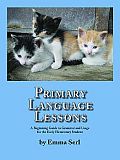Emma Serl’s Primary Language Arts and Intermediate Language Arts, originally published in 1911-1914, have proven popular with home educators, especially those trying to use a Charlotte Mason approach to education. The books have been slightly updated and improved to varying degrees by various publishers.
They incorporate narration, dictation, nature lessons, and memorization of poetry in keeping with Mason's ideas. Specific grammar and composition lessons are intermixed to create a very balanced approach to language arts. Artwork reproductions (in black and white) are used as the basis for a number of lessons as are myths, legends, fables, fairy tales, historical vignettes, biographies, Bible stories, and nature lessons. Like many school books written around the turn of the last century, they include occasional mention of God but none of Jesus that I found. Bible stories are presented in the same vein as other selections, so I would consider these books Christian-friendly but not overtly Christian.
Hillside Education (Catholic version) and My Father's World have produced other versions of Emma Serl’s books. These Living Books Press editions are similar in content to the originals but the consumable format might make them easier to use than other formats.
The books have been reproduced with much of the content remaining as it was originally written. The age of the books does create some interesting challenges for modern day children. For example, one lesson on airships and balloons asks, “What is the motive power of an airship?” Clearly airships must be dirigibles of some sort since the next lesson picks up with children imagining taking a trip in an airship. They are to tell what they think they would see as they “looked over the sides” (ILL, Part 2 p. 45). Nature and everyday life in an agrarian society are common topics throughout the books. While children living in the country might readily answer many of the questions, children raised in the suburbs or in a city will likely have to research answers to questions like, "Which [of fifteen types of birds listed] are seed eaters? Which are sweet singers?” (ILL, Part 1 p. 24). Nature study is so prominent that you might be able to create science lessons from some of the language activities! Some of the language is archaic or unfamiliar to modern children so use your judgment as to whether to skip, substitute, or explain in such instances.
Emma Serl’s first book, Primary Language Lessons, is intended for second and third graders, while Intermediate Language Lessons is for grades four through six. While other publishers have maintained the two-book format, Living Books has divided Intermediate Language Lessons into three separate books to keep the size manageable.
Primary Language Lessons deals with word usage, punctuation, capitalization, abbreviations, contractions, letter writing, memorization and recitation of poetry, retelling or rewriting of brief narratives, copywork, and dictation. Overall emphasis is upon proper word usage in both spoken and written communication.
Intermediate Language Lessons (three volumes) takes the above topics to more challenging levels and adds the study of parts of speech (although no diagramming is taught), debate (yes, that's correct), outlining, and a variety of composition skills including story writing.
Parents will need to explain, direct, and interact with students on most of the lessons. These books are not for independent study even though students will have some assignments to complete on their own. Lessons include some fill-in-the blank exercises, but students will do a great deal of copying, dictation, and original writing.
Living Books versions are printed on full 8.5” x 11” pages in contrast to the Lost Classics smaller books. Lost Classics books have either hardcover or softcover book that are not meant to be consumable while Living Books versions have added lines and space for students to write directly in the books. To make that easier, these books have plastic spiral bindings so they will lie flat.
Living Books editions also have appendices that include indexes, biographies of the authors and artists included for each volume, plus a few other extras such as U.S. Postal abbreviations in Intermediate Language Lessons Part I and four additional poems in Part 3.
No teachers editions are available for Living Books editions. While they would be helpful they are not essential.
Primary Language Lessons is used in the Living Books Curriculum for grades 2 and 3, while the three Intermediate Language Lessons are used in grades 4, 5 and 6. However, there is nothing to limit these books to use with the LB curriculum.









